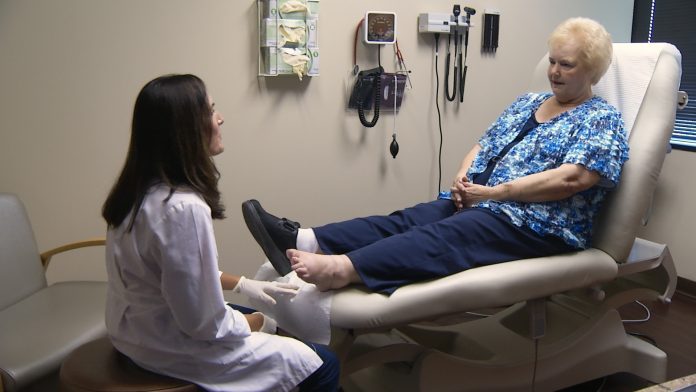
OU Experts urge awareness and proper foot care for those with diabetes
Most of the time, a simple bandage can heal a wound, but one Oklahoma woman discovered it would take a lot more to heal the wound on her foot, a problem concealed by the absence of pain.
It is an all too common story in the world of diabetes care and one that could lead to amputation if ignored. The experts at the Harold Hamm Diabetes Center at the University of Oklahoma know it well. With proper awareness and foot care, though, limbs and lives can be saved.
Elizabeth Hixon had no idea she had injured her foot on a recent trip to the store. She was focused on buying gifts. Hixon works year-round preparing presents to bring Christmas smiles to more than 60 orphans. It’s her way of honoring her kidney donor, a young, single mother of two children. On that day, though, another shopping trip for gifts ended with an unsettling discovery.
“I came home and took my sock off and my foot had blood on the bottom of it,” Hixon said.
The sock was soaked in blood, but she had felt no pain. Why? Hixon got her answer from Kiersten Weber, a podiatrist with the Harold Hamm Diabetes center.
“Unfortunately, it is very common. Elizabeth, having diabetes, also has neuropathy,” Weber said.
Neuropathy is nerve damage that can trigger numbness.
“When someone has lost that feeling, he or she may continue to walk and have no idea that an injury has happened,” Weber added.
People who have diabetes, like Hixon, are at increased risk for neuropathy. Combine that with reduced blood flow to the feet and they are also at greater risk of developing ulcers and infections that are difficult to heal.
“The complications that people experience can be devastating. In fact, the number one cause for hospital admissions for people with diabetes is foot deformities or foot infections. So I don’t think people realize how problematic a complication involving your feet can be in terms of your overall well-being when you have diabetes,” Weber said.
She also pointed out that these complications that occur in the feet are almost always preventable. In addition, early diagnosis and care is critical to protecting your foot, your leg and ultimately your life.
Weber said diabetes is the number one cause of lower extremity amputations.
To make matters worse, a lower extremity amputation puts the patient at risk for even more problems in the future.
“When somebody has an amputation, the risk of a second amputation within five years is 50 percent. The mortality rate in these patients also goes sky high as high, if not higher than some cancers,” Weber said.
Those facts did not escape Hixon, who had already seen what can happen when a wound gets out of control in someone with diabetes.
“I have a sister-in-law who is a diabetic and has lost a foot and a leg,” she said.
Hixon was determined to do all she could to help her foot heal and to avoid future injury.
Diabetes experts know proper foot care is critical for those living with diabetes. That includes checking one’s feet regularly for changes.
“Daily activities that I always try to stress, similar to brushing your teeth every day, include examining your feet. Every day, it’s important to look at your feet. I know that sounds simple, but especially when you’ve lost that feeling you have to use your other senses – your eyes and your hands – to examine your feet. You’re looking for sores, open wounds and any areas of discoloration,” Weber said.
Hixon now examines her feet religiously each and every day, keeping an eye out for any new calluses, bruises or cuts.
“You want to make sure you don’t get a toenail infected or something that would be a minor problem for anyone else, because it can be major for a diabetic,” she said.
Weber also fitted Hixon with custom-made shoes that aid healing and offer additional protection. She advises all patients with diabetes never to go barefoot.
Under Weber’s care, Hixon’s wound healed in just two weeks. Because of the nerve damage, though, the risk of another injury will always be there, and Hixon said she is not only taking all precautions, she urges others she knows with diabetes to do the same.
Meantime, she is back to shopping and wrapping hundreds of gifts, many purchased by her and some donated, that she and her husband will deliver in December to a home for orphans.













